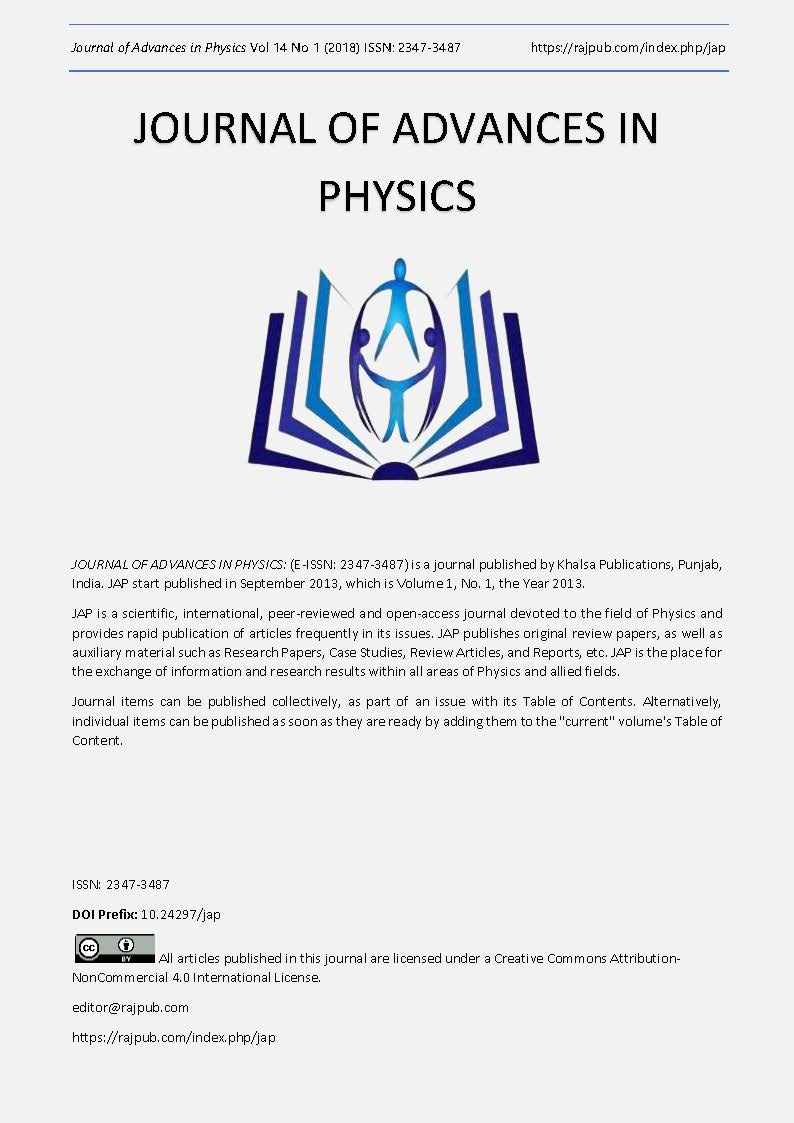Thermal Conductivity Modeling of Propylene Glycol - Based Nanofluid Using Artificial Neural Network
DOI:
https://doi.org/10.24297/jap.v14i1.7177Keywords:
Artificial neural network, Modeling, Nanofluids, Thermal conductivity enhancement, Propylene glycolAbstract
The article introduces artificial neural network model that simulates and predicts thermal conductivity and particle size of propylene glycol - based nanofluids containing Al2O3 and TiO2 nanoparticles in a temperature rang 20 - 80oc. The experimental data indicated that the nanofluids have excellent stability over the temperature scale of interest and thermal conductivity enhancement for both nanofluid samples. The neural network system was trained on the available experimental data. The system was designed to find the optimal network that has the best training performance. The nonlinear equations which represent the relation between the inputs and output were obtained. The results of neural network model and the theoretical models of the proposed system were performed and compared with the experimental results. The neural network system appears to yield the best fit consistent with experimental data. The results of the paper demonstrate the ability of neural network model as an excellent computational tool in nanofluid field.
Downloads
References
Bashirnezhad, K., Rashidi, M. M., Yang, Z., Bazri, S. and Yan., W. M. 2015. A comprehensive review of last experimental studies on thermal conductivity of nanofluids. J Therm. Anal. Calorim. 122, 863-884.
Choi., S. U. S. 1995. Enhancing Thermal Conductivity of Fluids with Nanoparticles in Developments and Applications of Non Newtonian flows. American Society of Mechanical Engineers. 23, 99-105.
Barbe´s, B., Pa´ramo, R., Blanco, E., Pastoriza-Gallego, M. J., Pin˜eiro, M. M., Legido, J. L. and Casanova, C. 2013. Thermal conductivity and specific heat capacity measurements of Al2O3 nanofluids. J Therm. Anal. Calorim.11,1615–1625.
Chandrasekara, M., Sureshb, S. and Senthilkumara, T. 2012 Mechanisms proposed through experiments investigations on thermos-physical properties and forced convective heat transfer characteristics of various nanofluids. a review. Renew Sustain Energy Rev.16, 3917–38.
Gowda, R., Sun, H., Wang, P., Charmchi, M., Gao, F. and Gu., Z. 2010. Effects of particle surface charge, species, concentration, and dispersion method on the thermal conductivity of nanofluids. Adv. Mech. Eng. 2010, 1–10.
Hemmat Esfe, M., Saedodin, S., Wongwises, S. and Toghraie., D. 2015. An experimental study on the effect of diameter on thermal conductivity and dynamic viscosity of Fe/water nanofluids. J Therm Anal Calorim. 119, 1817–1824.
Hwang, Y. J., Ahn, Y. C., Shin, H. S., Lee, C. G., Kim, G. T. and Park, H. S. 2006. Investigation on characteristics of thermal conductivity enhancement of nanofluids. Curr. Appl. Phys. 6, 1068.
Mintsa, H. A., Roy, G., Nguyen, C. T. and Doucet, D.2009. New temperature dependent thermal conductivity data for water-based nanofluids. Int. J. Therm. Sci. 48, 363-71.
Aishwarya, V., Suganthi, K. S., Rajan, K. S. 2013. Transport properties of nano manganese ferrite–propylene glycol dispersion (nanofluids): new observations and discussion. J. Nanopart. Res. 15, 1774-1788.
Palabiyik, I., Musina, Z., Witharana, S. and Ding., Y. 2011. Dispersion Stability and Thermal Conductivity of Propylene Glycol Based Nanofluids. J. Nanopart. Res. 13, 5049–5055.
Suganthi, K. S., Anusha, N. and Rajan, K. S. 2013. Low viscous ZnO–propylene glycol nanofluid: a potential coolant candidate. J. Nanopart Res. 15, 1986-1992.
Sun, T. and Teja, A. S. 2004. Density viscosity and thermal conductivity of aqueous solutions of propylene glycol, dipropylene glycol, and tripropylene glycol between 290 K and 460 K. Journal of Chemical and Engineering Data. 49, 1311-1317.
Tillman, P. and Hill, J. M. 2007. Modelling the Thermal Conductivity of Nanofluids. IUTAM Symposium on Mechanical Behavior and Micro-Mechanics of Nanostructured Materials. 144, 105–118.
White, S. B., Shih, A. J. and Pipe, P. K. 2011. Investigation of the electrical conductivity of propylene glycol-based ZnO nanofluids. Nanoscale Research Letters. 6, 346-351.
Xie, H., Yu, W., Li, Y. and Chen, L. 2011. Discussion on the thermal conductivity enhancement of nanofluids. Nanoscale Research Letters. 6, 124 - 136.
Yapici, K., Cakmak, Nese K., Naciye, I. and Uludag, Y. 2014. Rheological characterization of polyethylene glycol based TiO2 nanofluids. Korea-Australia Rheology Journal. 26, 355-363.
Kumar, P. M., Kumar, J., Tamilarasan, R., Sendhilnathan, S. and Suresh, S. 2015. Review on nanofluids theoretical thermal conductivity models. Engineering Journal. 19, 67-83.
Wang, X. and Mujumdar, A. S. 2008. A Review on nanofluids – Part I: Theoretical and Numerical investigations. Brazilian Journal of Chemical Engineering. 25 613 – 630.
David Kriesel. 2007. A Brief Introduction to Neural Networks.
Kumar, K., Mitra Thakur, G. S. 2012. Advanced Applications of Neural Networks and Artificial Intelligence: A Review. International Journal Information Technology and Computer Science. 6, 57-68.
Peterson, C. and Rognvaldsson, T. 1991. An introduction to artificial neural network. CERN.1991,113-170.
El–Bakry, M. Y. 2003. Feed Forward Neural Networks Modeling for K-P Interactions. Chaos, Solitons and Fractals.18, 995-1000.
El–Dahshan, E., Radi, A., El-Bakry and M. Y., El-Mashad, M. 2009. Artificial Neural Network Modeling in Heavy Ion Collisions. International Journal of Pure and applied Physics. 5, 1-14.
Michael Negnevitsky. 2005. Artificial Intelligence: A Guide to Intelligent System, Addison Wesley, England.
El-Bakry, Mostafa Y., Habashy, D. M. and El-Bakry., M. Y. 2014. Neural Network Model for Drag Coefficient and Nusselt Number of Square Prism Placed Inside a Wind Tunnel. International Journal of Scientific Engineering Research. 5,1411-1417.
El-Bakry, Mostafa Y., Habashy, D. M. and El-Bakry, M. Y. 2015. Effect of Particles on Flow Structures in Secondary Sedimentation Tanks Using Neural Network Model. International Journal of Scientific and Research. 6, 49-54.
Downloads
Published
How to Cite
Issue
Section
License
 All articles published in Journal of Advances in Linguistics are licensed under a Creative Commons Attribution 4.0 International License.
All articles published in Journal of Advances in Linguistics are licensed under a Creative Commons Attribution 4.0 International License.




